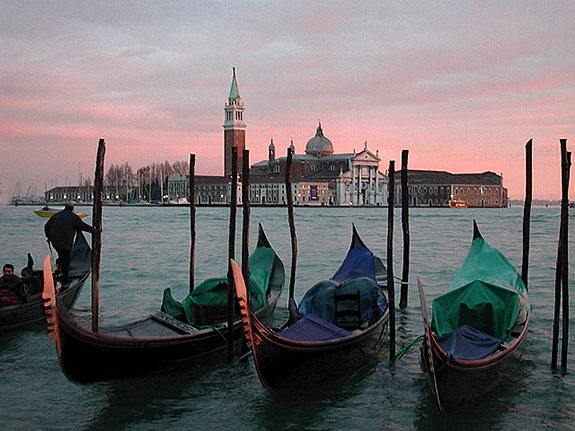 |
"Art collectors shop at the Venice Biennial and do their buying at the Basel Art Fair.” This is a not-so-old art world saying that gets evermore complicated with the new and vast proliferation of curated biennial exhibitions and gallery-focused art fairs taking place around the globe, but there is something to it. On the other hand, the reverse also seems to be coming true, in that the market gets tested and then made at Basel, and then historically contextualized and certified for museum consumption in Venice. The magic seems to work both ways.
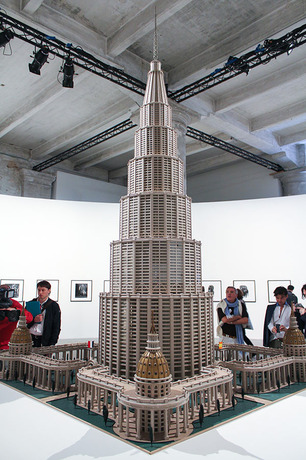 |
The trick to doing this successfully is to avoid all obvious programs of predictability while at the same time not overwhelming the viewer with too much too quickly, so that the cumulative effect of the experience becomes primary even as the engagement with specific works of art becomes little more than a meditation on the contribution of specific gargoyles to the overall design of the cathedral. Of course, the problem that comes with achieving this is that it gradually becomes its own program of predictability, but that is more a problem for future exhibitions rather than the one under consideration here. Maybe.
Gioni has done a few things to suggest that his exhibition seeks to rival the more prestigious (and much better funded) Documenta exhibitions held every five years in Kassel, Germany. One indication of this is the two-volume mega catalog that accompanies the exhibition. It’s supported by an additional short guide that viewers could use while exploring the multitude of artworks and other symbolic tea leaves that were part of the show. Another lies in his timely choice of title for the curated portion of the Biennial that takes place in two main venues: the long and cavernous Arsenale and the labyrinthine Central Pavilion in the Giardini. The title is Ill Palazzo Enciclopedico (The Encyclopedic Palace), named after a building that was imagined but never built, except in the form of a finely wrought architectural model that is the first thing that the viewer encounters upon entering the Arsenale.
.jpg) |
It has a story: In 1955, an Italian emigrant living in rural Pennsylvania named Marino Auriti filed a patent for the construction of a vast 139-story building that was designed to contain and celebrate all of the world’s knowledge and achievements. If constructed, it would stand 700 meters tall and take up 12 city blocks. Clearly, the inclusion of this work is prompted by a few contemporary considerations, one being that we live in an age where the internet itself will soon fulfill Auriti’s grand vision. Another is how it serves as an absurd beacon for the impossible dream entailed in curating any global megashow.Gioni admits as much when he closes his own curatorial statement with these words: “The Encyclopedic Palace emerges as an elaborate-but-fragile construction, a mental architecture as fantastical as it is delirious. After all, the biennial model itself is based on the impossible desire to concentrate the infinite worlds of contemporary art into a single place, a task that now seems as dizzyingly absurd as Auriti’s dream.”
 |
 |
These reflected the old museological tradition of the wunderkammer (“cabinet of curiosities”) or its American cousin, the freak show, harking back to an era when a museum was simply any place where people would pay to see what was contained within it. Ames’ little menagerie consisted of a variety idiosyncratic demi-gargoyles that looked like faithful replicas of the beasts that were tossed overboard when Noah’s Ark reached maximum capacity, their superb craftsmanship a delight to eye and mind. Also exhibiting a refined craftsmanship were Domenico Gnoli’s 1967 suite of drawings titled What is a Monster? Each of these zoological fantasies of hybrid animals such as a fish-tailed snail lounging on a couch could be taken as a small prophesy of the gene-spliced hybridity that is quickly becoming a biotechnological reality. I was also taken with Cristiana Soulou’s sweet tempered ink-brush and graphite drawings inspired by Jose Luis Borges’ Book of Imaginary Beings, a tale about the animal farm of world mythology. In an art world full of loud shouting, the whispering tone of these works struck a welcome note of elegance.
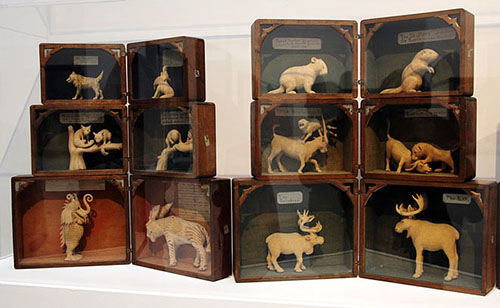 |
In Ill Palazzo Enciclopedico there is no clear distinction between the animal kingdom and those aspects of human nature that echo the proverbial animals within, so assessment of the exhibition’s bestiary of the fantastic has to also include certain representations of the human-as-beast, a staple of 1940s Surrealism that so often haunts the Pop Surrealism of the 1990’s that shapes so much of Gioni’s exhibition. The modestly scaled paintings of Eugene Von Bruenchenhein from the mid-1960s bear this out: they are clearly figurative, but the figures that are represented within these works seem neither human or animal. Instead, they come across as supernatural avatars pulling duty as characters in a drama of metaphysical confrontation. A very different kind of metaphysical drama is found in Dorothea Tanning’s pair of small paintings from the mid 1940s, one of which shows a girl in a wintery landscape morphing into a snake while a pair of hopeful comets soars overhead. These modestly scaled works present themselves as poetic puzzles that reveal how subjective interiority is made up of a multitude of distinct motive-clusters that are not always in concert.
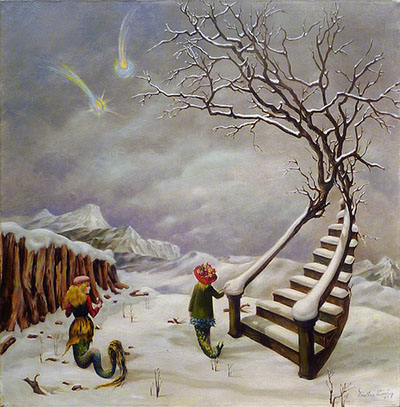 |
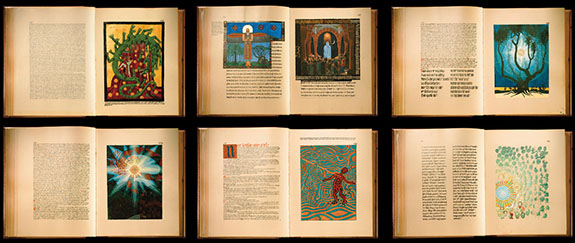 |
 |
That much said, one of Jung’s key concepts animating the organization of Gioni’s Palazzo is his distinction between extroverted and introverted personality types. The exhibition plays this distinction out with dizzying exaggeration and occasionally extreme juxtaposition, but the general drift of the Central Pavilion was one of introversion, while extroversion moved into the foreground at the Arsenale. The old differential diagnosis terminology of extreme introversion and extroversion are applicable here. Those would be catatonia and paranoid schizophrenia, and both are somehow held in a precarious balance of proximity and occasional dialog by the exhibition. The extreme of introversion was found in Enrico Baj’s series of fabric collages morphing into surreal portrait heads from the early 1960s, works that not-so-playfully confuse interior and exterior cranium anatomy of their female subjects.
 |
On the subject of extreme extroversion and flagrant loss of impulse control, we can point to Ryan Trecartin’s quartet of Not Yet Titled video installations at the Arsenale. These were disturbing to say the least. They offered the viewer cozy little sitting areas that looked like tropical cabanas, each playing soothing music and each offering a welcome opportunity to sit down and watch one of four video feeds while listening in on headphones. But when the headphones come on, hell ensues, because the viewer is then transported to a world inhabited by violent, irrational and disturbed people who were all too comfortable reveling in their state of depraved glory, either by committing wanton acts of destruction, or by listening to a self-styled guru proclaim that a mythical group called “we” had evolved from animations, which evolved from
humans. This assertion was disputed by an overdressed transvestite who mocked the guru at every turn. Così va la via per l'inferno.
Media Art: Two years ago, Christian Marclay’s projection titled The Clock was the consensual favorite in Bice Curriger’s 54th Venice Biennial, and the space that contained it in the Arsenale was henceforth honorably occupied by an overlapping 16-screen projection by Stan VanDerBeek’s titled Moviemural, which was a digital rescue of portions of one of the artist’s well-known earlier film projection works titled Moviedrome from 1965. Minus loud music masking the clatter of old film projectors, the piece still looks as timely now as it did four decades ago. Even at that early date, we can see how much of what was then called experimental cinema relied on a speeding up of juxtaposed images, many extracted from news broadcasts and television adverts. Other presentations featured the retro-clatter of 8 and 16-millimeter projectors showing film loops, suggesting that such devices have become technological fetish objects. For example, in the six installations by Joao Maria Gusmao and Pedro Paiva, we see what looks like a private image diary shot in Mozambique, where the camera lingers on various peripheral fascinations that allude to a story that is never fully told. Harry Smith was represented by a similar film loop titled Heaven and Earth Magic (1958-1962) installed in the
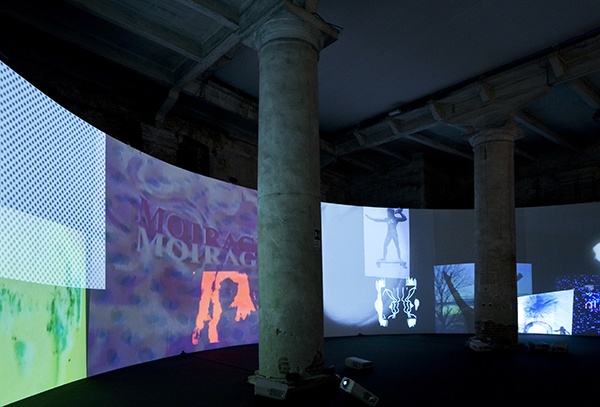 |
Central Pavilion, but like VanDerBeek’s Moviemural –actually, much more so– it gains traction from its embrace of Surrealist-inspired juxtapositions, some abrupt, some subtle and all very much in the mode of Joseph Cornell’s films from around the same time period. Smith, however, reaches even further back to the sheer zaniness of the old George Méliés films from the turn of the century. Back in the Arsenale, Dieter Roth set a new standard for personal surveillance in his piece titled Solo Scenes (1997-98), which consisted of 131 monitors showing various feeds of the artist alone in his studio during the last year of his life. Here, we see him performing mundane tasks, as if the capture of some special moment that never quite happens is of paramount concern. No doubt, the piece benefited from the Edward Snowden revelations about vast
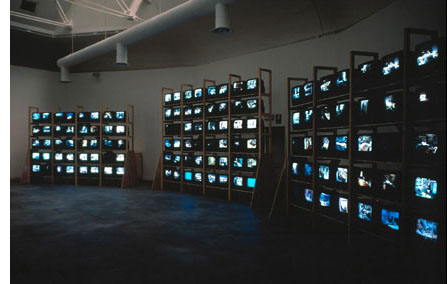 |
undisclosed programs of domestic surveillance, but remembering 1998 as the high point of the “technology-will-change-the-world” fantasy, we might detect other motives in play, most especially the fact that technology has done little more than amplify the operations of automation and surveillance, and neither are good for democracy.
NYC 1993: Experimental Jet Set, Trash and No Star: Just as recent iterations of Documenta have embraced multiple “platforms” taking place in far flung geographical locales, so too can we consider this exhibition organized by Gioni at the New Museum in New York this past spring to be an unofficial platform of Ill Palazzo Enciclopedico, or at the very least a kind of keynoting overture. This time capsule of an exhibition reached back two decades to the early months of the Clinton era to memorialize a vexed art historical moment when a momentary crash in the art market turned out to only be its post-government funding recalibration. It was a year that gave us Elizabeth Sussman’s infamous “politically correct” Whitney Biennial, which took place a few short months after Jeff Koons’ first major retrospective. The previous year, Paul Schimmel presented his Helter Skelter exhibition at LA MOCA, meaning that the decade of Pop Surrealism was fully underway, supporting the transition of museums from government-supported bastions of intellectual pretense to turnstile supported urban entertainment destinations pulling double duty as esthetic hedge funds. 1993 touched on all of these themes, and captured the spirit of dejection and panic of its chosen moment. It also registered the early attributes of a soon-to-be global style that could be called Post-Modern Institutional Rococo, of which Pop Surrealism is one of many visible parts. For those who are hoping that this will show itself as a passing fad, I want to note here the art historical fact that the French Rococo lasted well over a hundred years, sustained by the attributes of wit, irony and an ornate, albeit empty, elegance. This fact suggests that we might be in for a very long ride. Excepting for growing exponentially larger during the past two decades, the world of contemporary art has not changed much since that time of the cloning and coding of that which was once known as the avant-garde, to use phraseology borrowed from a book published by Donald Kuspit that same fateful year. Although it jettisons the tendentious identity politics of the Sussman show, most of the work in Ill Palazzo Enciclopedico seems to confirm this point, and I cannot but help note here that Gioni was only 20 years old in 1993.
.png) |
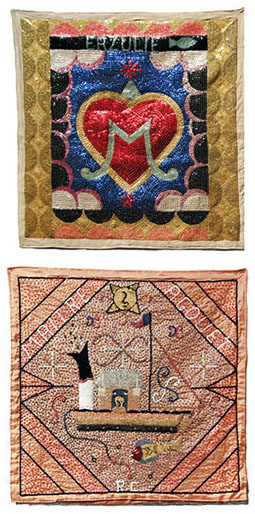 |
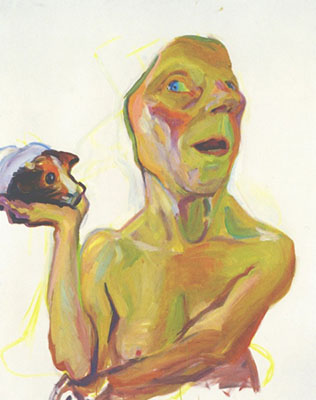 |
among many different artistic media, tolerated in the manner that one might treat an embarrassing but not-yet despised relative who cannot be uninvited to the party. Most of the best painting in Ill Palazzo Enciclopedico was housed in the Central Pavilion, including some recent self-portraits by Maria Lassnig, who, along with
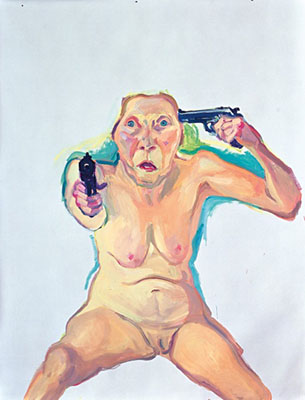 |
Marisa Merz, received the coveted Golden Lion awards for best in show. Clearly, these choices were more of lifetime achievement award than the best of show, but Lassnig’s paintings were still stunning, featuring deft, brightly colored impasto mimics of bodily flesh that seemed subtly animated in a way that drew a haunted analogy between layers of paint and the body’s physical acquisition of experience. Nearby, there was another room containing cold grey seascapes by Thierry De Cordier, works that balanced a subdued painterliness with pictorial precision while subtly editorializing on the lonely tribulations inherent in the very act of painting (understood as a perilous attempt to wrangle liquid and atmosphere into some kind of ideal form). Imran Qureshi adopted the forms and techniques of 16th and 17th century Mughal period miniature painting to make high craft statements about the friction between tradition and modernity, this by way of painting everyday Pakistani
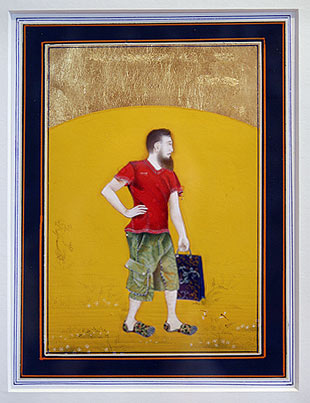 |
youths down-dressed in hipster outfits, all cast as heroic avatars in a new historical chapter of national identity formation. He accomplishes this by dressing them in clothing that bespeaks an international hipsterism, subtly proclaiming allegiance to neoliberalism while also defying Islamic convention. In the Arsenale, Albert Oehlan and Wade Guyton showed how technology and painting are working out their new relationship, with perplexing results. In Oehlan’s case, it was revealed in a suite of large, colorful and brittle inkjet outputs that were essentially digital photo collages printed at very high resolution, looking more than a bit too much like James Rosenquist’s work from the 1960s to make a compelling case for themselves. Guyton showed even larger grayscale works that resulted from the random registration errors of a malfunctioning inkjet printer, these just happening to resemble the work of Agnes Martin. The rather obvious question that these works pose is that if there is a difference between these and Martin’s work, how important is that difference, and why so? The answer reaches back to articles of faith and doubt about the way that handmade art can represent and fully convey a process of psychic conversion that a reliance on the mechanical cannot achieve, even if it relies on the manual repetition of regularized form. Once again, we see the postmodern tension between art understood as a management of effect challenging the more time-honed notion of art as a manifestation of affect. (See Platonism.) And proving that even some handmade art cannot achieve conversion were large works by Daniel Hesidence, which featured fields of aqua-blue color saturation overlaid with crisp graphic elements that seemed like homages to Duchamp’s Network of Stoppages (1914). These were among the very few works in Ill Palazzo Enciclopedico that seemed in anyway influenced by the now waning vogue of Provisional Painting, and to the degree that they do not try excessively hard to be casual, it might be better to call them examples of Post-Provisional Painting, if there can be such a thing. From the time of Giotto up until that of Minimalism, art in general and painting in particular was an attempt to clarify and represent the center of experience of the cultural conditions surrounding it, but after that time, much self-consciously advanced art seems to have tasked itself with either
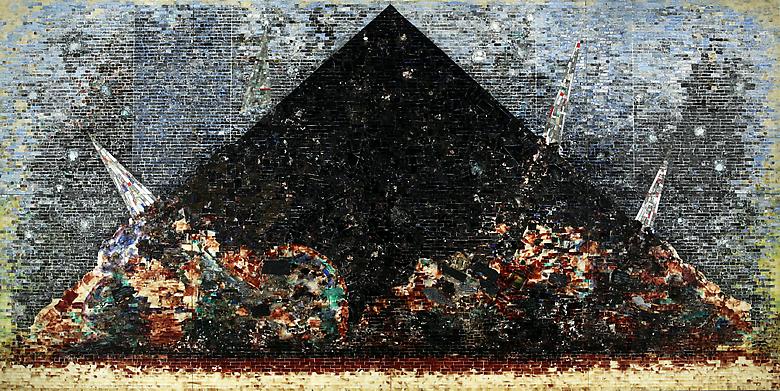 |
representing multiple centers of experience, or in another key, revealing the very idea that the center of experience lives in a perpetual elsewhere that can only intimated by way of a subtly oblique pictorial strategy. Let’s give Hesidence the benefit of the doubts that his work raises and say that it fits into the later group. Or not. The idea of painting representing multiple centers of experience was clearly evident in the single, very large work by Jack Whitten titled 9-11-2001 (2006), which at first glance appears as a giant black triangle hovering over the viewer’s head, lurking behind Peter Fritz’s Lilliputian fantasy land of alpine harmony. The close-up view of Whitten’s painting is where the real reward takes place, as we see that the work is in fact a giant mosaic of materials arranged from the very tiny to the very large, much of which are suffused in a kind of lava flow of dark, tar-like paint. Here we see the analogy the piece makes between the terrorist attacks and the eruption of Mount Vesuvius in 79 C.E. that destroyed the Roman city of Pompeii.
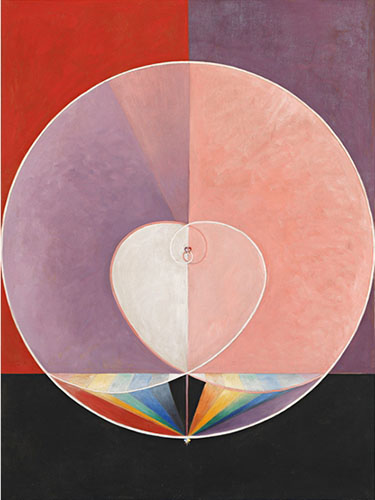 |
Religion (see also Outsider Art): In almost 200 original hand drawn ink-on-paper panels, R. Crumb gives us the Book of Genesis, or a large part of it. Not only do the drawings for his 2009 graphic novel of the same name show us Crumb at his very best in terms of crisply stylized information-dense drawing, it also restrains the comic impulses that usually earmark his work, making his Genesis look oddly respectful of its source material. It wasn’t exactly pious, but it was nowhere near being as over-the-top or slapstick as his earlier work. A very different theology was conjured in the collection of watercolor Tarot Cards made by Aleister Crowley and Frieda Harris in 1938. These expanded the conventional symbolism of the tarot to encompass a host of obscure and occult references that were in keeping with the religion of Crowley’s own revelation, initially
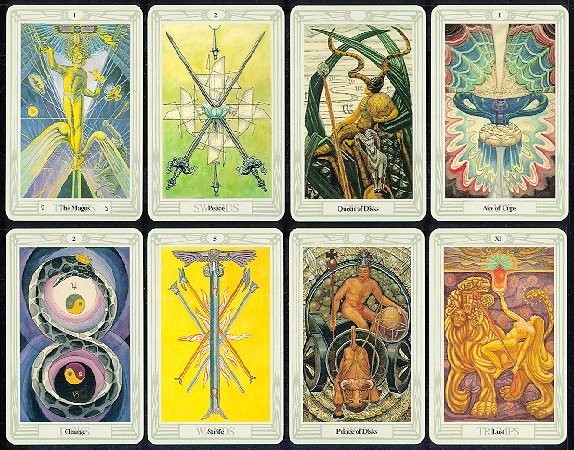 |
called Thelema, later becoming the Hermetic Order of the Golden Dawn (see also Extroversion/Introversion). Here is an interesting FYI: Bram Stoker and William Butler Yeats were in the congregation. Renegade Theosophist turned Anthroposophist Rudolf Steiner also had a congregation, and in 1923 one of its members had the brilliant idea of covering the blackboard that he used to illustrate his lectures with black paper, thus preserving many of the multi-color chalk diagrams whose spontaneous cosmological significations would later influence Joseph Beuys. After seeing the generous selection of three groupings of 18 of these works arrayed in the Central Pavilion, all I could say was eat your heart out, Cy Twombly.
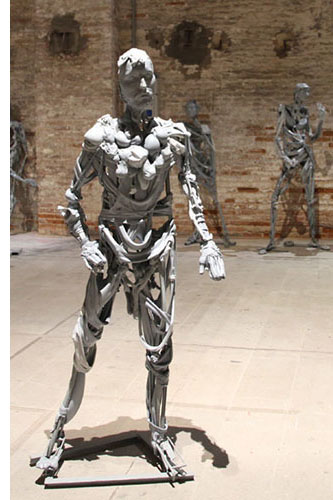 |
takes his famous piece titled The Kiss (1907-1914) one better by revealing itself as an octopusian clutch of phalli penetrating multiple orifices. It was made out of stuffed and knotted nylon stockings, but for a moment I could have sworn that it was plaster or clay. Pawel Althamer filled a large room with about 80 almost life-sized figures that he called Venetians, made from bent steel and swaths of rubberized fabric. Essentially, these were pipe cleaner sculpture writ large, but many of them also had plaster cast human faces, making them look like eerily zombified doppelgangers for the various raconteurs and boulevardiers who inhabit the Piazza San Marco.
Sherman, Cindy (see also New York, 1993): For an artist who does not have any of her own work in Ill Palazzo Enciclopedico, Cindy Sherman does seem to loom large. In the Arsenale, there is a section of work that she curated, and its mission seemed to be one of gathering Cindy Sherman surrogates, including deranged dress-up photos by Phyllis Galembo and a vintage collection of creepy close-up photographs of model railroad figurines made by Laurie Simmons and Allan McCollum in 1985. It was hard to detect exactly where the Sherman area began and ended, but I am pretty sure it included life-sized photorealistic sculpture from the late 1970s by Duane Hanson and John DeAndrea, the former presenting a befuddled looking shopper clutching a rather hilarious shopping bag, the latter giving us a nude young woman who seemed to be on the verge of becoming a corpse. The sole, achingly absurd painting by George Condo from 1985 of a long necked tiny-headed art dealer from was also memorable, as was a fairly extensive collection of early 1970s photos that Sherman has gathered into 15 tightly organized archival albums, some of “normal” families and others of rather theatrical transgender performers. This collection may be worth a closer look in terms of how the images it contains may have been used a source materials for Sherman’ own work, representing something akin to Gerhard Richter’s ongoing Atlas (1962-2012) of photographs to be used as ideas for paintings.
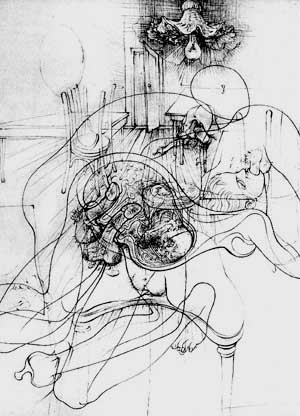 |
The section also reminded us that surrogation cuts both ways, by way of its inclusion of a suite of 1968 engravings by Hans Bellmer titled The Little Treatise on Morals, which not only evidenced a highly refined draftsmanship, but also a level of delirious erotic perversity that reveals how indebted Sherman’s famous sex doll series is to the work of the Swiss surrealist. I also want to call attention to what were clearly the most unsettling of all of the Cindy Sherman surrogates, and they were not anywhere near any of the others or even in the Arsenale. They were a small troop of handmade dolls made by Morton Bartlett at some point prior to his death in 1992, each dressed in awkwardly tailored garments that seemed poorly fitted. These quarter-scale figurines were finely, even obsessively crafted, but their most inescapable attribute laid in how, in Turn of the Screw fashion, they seemed simultaneously innocent and demonic, and authentically perverse.